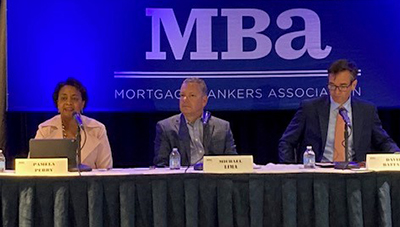
MBASecondary23: Solving the Affordability Puzzle

(l-r) Pamela Perry (Freddie Mac), Michael J. Lima (Click n’ Close Mortgage) and David Battany (Guild Mortgage) discuss affordable housing challenges at #MBASecondary23.)
NEW YORK–Affordability is among the top challenges for the housing market. Having strong counterparty relationships and sustainable products helps lenders to better serve the market and maintain liquidity.
Panelists here at the Mortgage Bankers Association’s National Secondary Market Conference & Expo discussed tangible tactics for lenders to maintain the bottom line while simultaneously tackling affordability challenges, as well as partnerships and programs that support this goal.
“The fundamental challenges to homeownership remain the same,” said Michael J. Lima, Managing Director for the Correspondent Lending Division of Click n’ Close Inc., Dallas. “Fifty-three percent of borrowers don’t have enough money for a down payment or struggle for a down payment, and down payment assistance programs are still difficult to access.”
“Economic conditions are still hitting at the most critical moments in the homeownership process: the down payment, the monthly payment and the first five years of homeownership, when capital assets are at their most critical,” said David Battany, Executive Vice President of Capital Markets with Guild Mortgage Co., San Diego. “Homeownership during that period takes the most chunk out of their income and inhibits their ability to save. It only takes one failed water heater to create a financial crisis. If we can help create a cushion or a cash reserve, it goes a long way toward sustaining homeownership.”
Battany, a member of the MBA Residential Board of Governors and a co-chair of the MBA 2022 Affordable Homeownership Advisory Council, noted most economists are predicting a mild recession this year. “My hope is that this will slow inflation, but there is still going to be a lot of pressure on borrowers,” he said. “Mortgage rates will probably come lower, but not very quickly.”
“We still see a lot of people on the sidelines,” Lima said. “Looking into the future, we’re focusing on sustainable homeownership; we see a need to balance the need between access to credit and homeownership.”
To address affordability, panelists offered several approaches. “Guild is a big FHA lender, and we see the value of down payment assistance programs,” Battany said. “A higher down payment results in lower closing costs and a lower interest rate. Whatever we can do to drive efficiencies can lower the cost of credit for all consumers.”
“The number one thing we can do for consumers is lower their interest rate,” Lima said. “We’re working here at this conference to meet with investors to understand how liquidity in bonds and mortgage pools translates to lower interest rates.”
Pamela Perry, Vice president of equitable housing within Mission and Community Engagement in the Freddie Mac Single-Family Acquisitions Division, McLean, Va., noted that many inefficiencies remain in the loan origination process. “There are thousands of down payment assistance programs out there, and we are deploying a tool, DPA-1, to work with local and state housing finance agency down payment assistance programs to enrich their data and enable loan officers and housing counselors to identify which DPA programs might be best for them,” she said.
Qualifying for a mortgage is another hurdle. “Credit scores are a complicated mathematical formula, but they shouldn’t be the only way people should qualify for a mortgage,” Battany said. “One way that gives the industry another tool is electronic predictive data—rent, utility bills, other payments that demonstrate a person has the ability to repay. We also think residual income could count toward creditworthiness—it can provide valuable insights that can be as predictive as FICO in determining a person’s ability to repay without creating additional risk for the system.”
Two other barriers currently stand in the way: rates, which have been elevated for the past year; and supply. “Up until 2008, we had oversupply of homes,” Battany said. “When 2008 hit, many builders left the industry and since then, we have had a housing shortage—as many as two-to-six million homes short, which is going to take years to catch up.”
Battany said one answer could be increasing manufactured housing. “These homes can be a game-changer,” he said. “They are modular buildings that can be constructed in 10 days. And the quality between manufactured housing and site-built construction is negligible. You can reduce costs; you can reduce time. If you can build homes much more quickly at much lower cost, then we can close the housing gap.”
“The mortgage industry needs to get over the stigma of manufactured housing,” Lima said. “Getting to change the mindset within the industry is key.”
